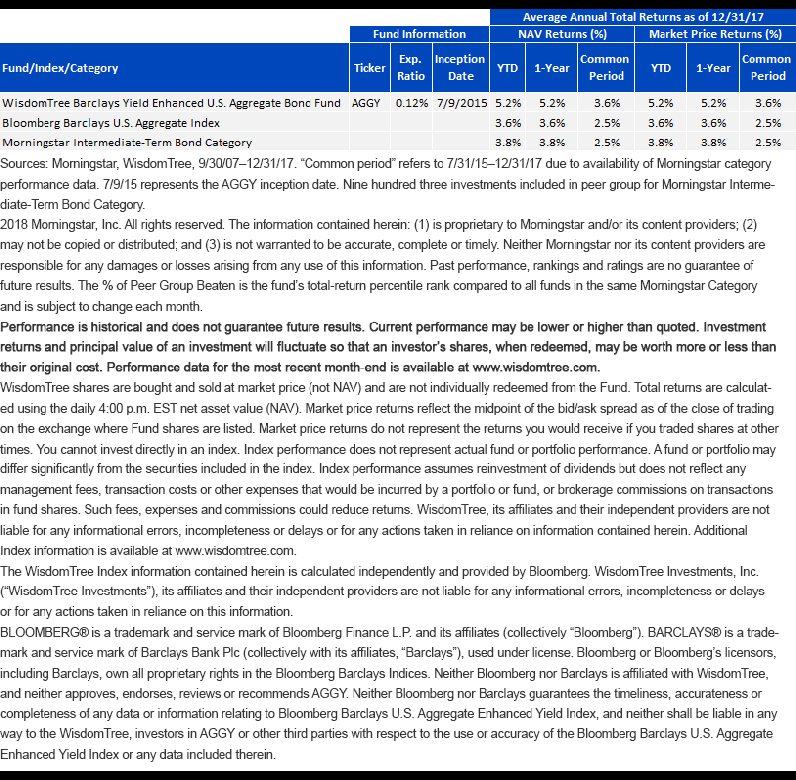How Do Enhanced Yield Fixed Income Indexes Stack Up vs. Active?


The research team at AQR Capital Management recently published a piece1 that attempted to explain why actively managed fixed income funds were able to deliver higher information ratios against their benchmarks than U.S. large-cap equity managers. The conclusion? Active fixed income managers tended to be over-weight credit risk compared to their benchmarks. While hardly surprising, that is precisely the rationale we focused on more than two years ago when collaborating with Barclays to create the Bloomberg Barclays U.S. Aggregate Enhanced Yield Index (Enhanced Yield Index). In this piece, we examine how the WisdomTree Barclays Yield Enhanced U.S. Aggregate Bond Fund (AGGY), designed to track the Index, has stacked up against other active managers in this space.
Strategy Review
The Enhanced Yield Index uses the same investable universe as the Bloomberg Barclays U.S. Aggregate Index, but then seeks to maximize yield while adhering to a series of constraints to limit risk. The resulting portfolio will generally be over-weight credit risk and under-weight U.S. Treasuries. Throughout its history, it has increased yield by 50 to 75 basis points (bps) while keeping duration within one year of the benchmark. All else being equal, the higher the starting yield of a bond portfolio, the higher the expected returns. Therefore, by extracting higher yields from the investment-grade investable universe, returns should increase. By applying constraints, we are also attempting to be cognizant about keeping tracking error volatility to 0.35% per month.
Real-Time Performance
As we show in the chart below, while our historical research was instructive, what really matters is how the strategy performs in real time. Since mid-2015, credit spreads have generally tightened, and interest rate volatility has generally been low. Overall, this environment has been favorable for most flavors of active and passive fixed income. Since inception, AGGY has outperformed 91% of all funds in the Morningstar Intermediate-Term Bond Category.2 Over the last year, it has outperformed 90% of all funds.3 Put another way, our approach has outperformed more than 815 active and passive managers in the core bond category. In our view, this continues to strengthen the case that it’s possible to enhance strategy returns by enhancing indexes versus relying on subjective portfolio manager discretion.


Conclusion
Fixed income managers have a variety of tools at their disposal to try to outperform the market. While some may be able to consistently outperform their benchmarks, it seems far more likely that many of these approaches boil down to systematic biases in their portfolios. While these approaches may not always outperform, we believe our approach to enhanced indexing can provide a value to investors comfortable with increasing risk at the margin in order to boost returns over market cycles.
1Source: “The Illusion of Active Fixed Income Diversification,” AQR Capital Management Alternative Thinking, 2017.
2Source: Morningstar rankings based on total returns 8/1/2015 through 12/31/17. Peer group rank 86 out 903 funds.
Important Risks Related to this Article
There are risks associated with investing, including possible loss of principal. Fixed income investments are subject to interest rate risk; their value will normally decline as interest rates rise. Fixed income investments are also subject to credit risk, the risk that the issuer of a bond will fail to pay interest and principal in a timely manner, or that negative perceptions of the issuer’s ability to make such payments will cause the price of that bond to decline. Investing in mortgage- and asset-backed securities involves interest rate, credit, valuation, extension and liquidity risks and the risk that payments on the underlying assets are delayed, prepaid, subordinated or defaulted on. Due to the investment strategy of the Fund, it may make higher capital gain distributions than other ETFs. Please read the Fund’s prospectus for specific details regarding the Fund’s risk profile.


